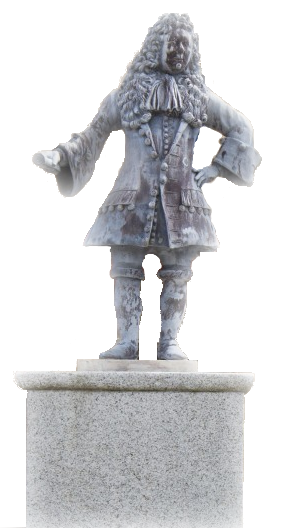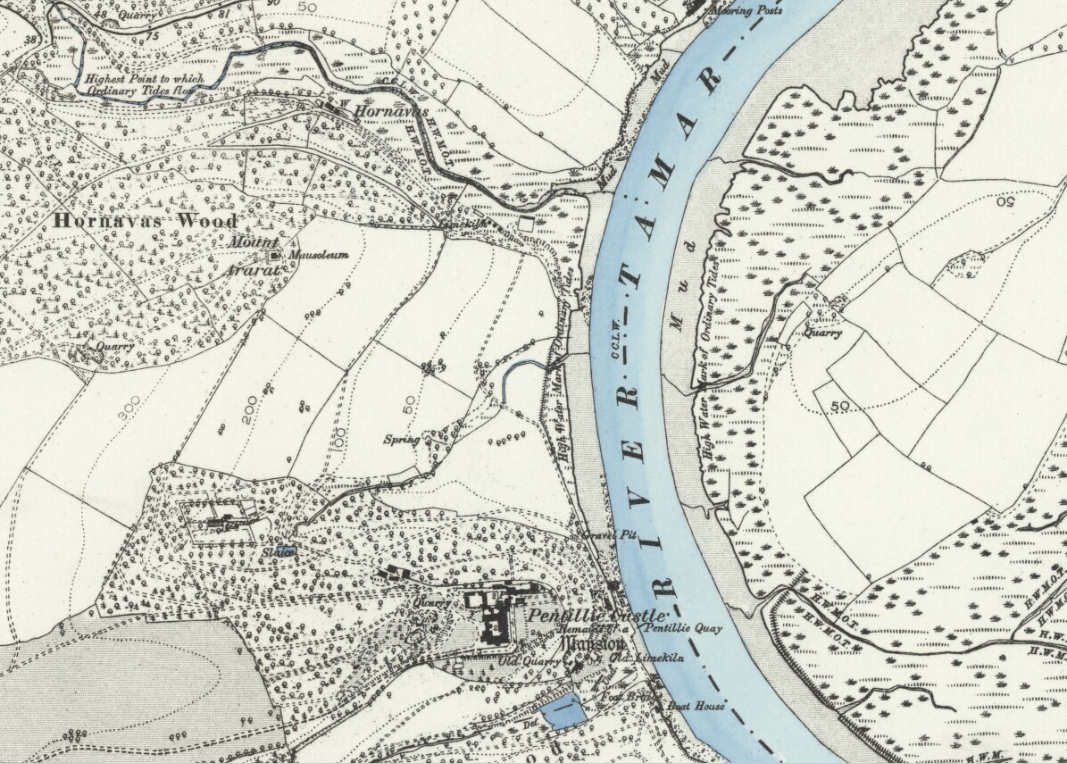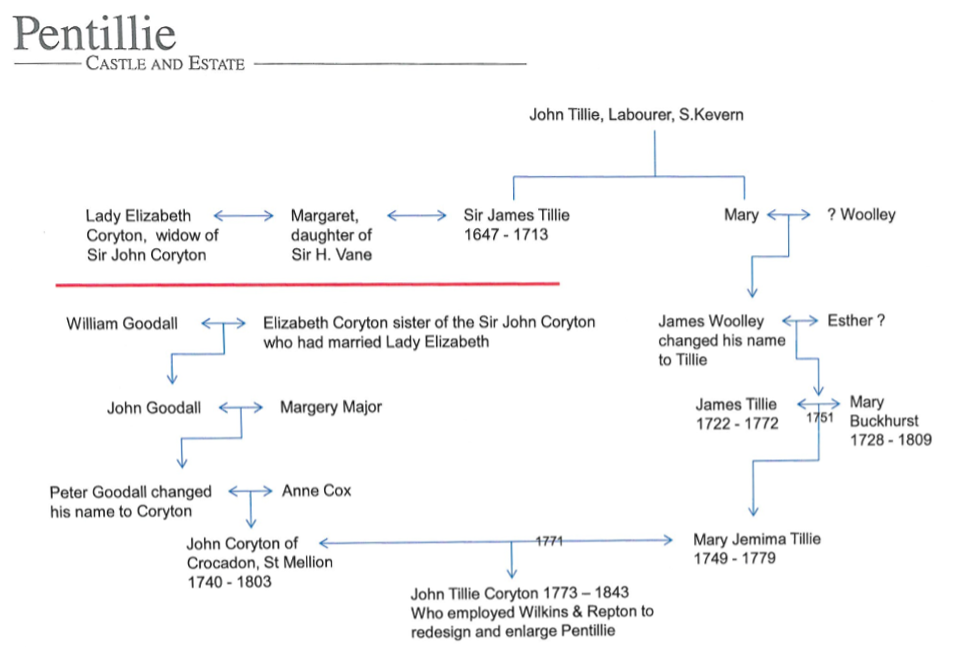The Pentillie Myth
PENTILLIE HISTORY

Sir James Tillie's Statue
Pentillie Castle is a grade II listed country house and estate on the bank of the River Tamar, Located a mile and a half south east of St Mellion and half a mile down river from Halton Quay. The land that is now part of the Pentillie estate was once part of the much bigger ‘Newton Ferrers’ estate near St Mellion that was the country seat of the Coryton family.
The Manor at Newton Ferrers dates back to Norman times and is recorded in the Domesday book of 1086.
The Coryton family were wealthy landowners with over 20,000 acres of land throughout Cornwall, and parts of nearby St Dominick belonged to the estate.
Sir John Coryton (1648 to 1690) was the second barronet of Newton (Ferrers Nr St. Mellion) and served in public office as sherrif of Cornwall, Mayor of Callington and twice as MP for Callington.
James Tillie (16 November 1645 – 15 November 1713) is described as “an extraordinary man of dubious character”.
He married Margarett Vane in 1680 but she died in 1682.
It is unclear quite how Tillie rose from a poor background to become Sir Johns’ land agent.
Amid “allegations that he had been rather too familiar with Elizabeth” and “suspicion that Sir John might have been poisoned”. Sir John Coryton died in 1690, mysteriously “and in great agony, at the young age of 42”.
Doing nothing to quell the suspicion Tillie married Elizabeth, Sir Johns Widow on 27th November 1691 in All Hallows church, London Wall,City of London. The marriage substantially improved Tillies wealth and on splitting the Newton Ferrers estate he set about building his own estate at Pentillie.
Construction at Pentillie took place between 1686 and 1695 as declared by the dates carved on the stone gate posts.
It is suggested that by a “great sum of money and false representation” James obtained a knighthood in 1687 from the then King, James II. It could be said that the now Sir James Tillie had delusions of grandeur. He commissioned a life size statue of himself in pose akin to that of the famous statue of Charles II in London. His statue can still be found standing in front of Pentillie.
The Death of Sir James Tillie

Sir James Tillie
Sir James died in 1713 aged 68 and left no heir. Possibly with a biblical reference he made sure that he would not be forgotten by constructing a tomb on a high hill, called Mount Ararat, overlooking Pentillie and the river Tamar.
Sir James believed that he would be “within two years” resurrected and left specific instructions that upon his death he should be placed in the tomb “dressed in his best clothes, wig and a fine hat” his hands to “be placed on his knees”. Surrounding him were to be his favourite books and bottles of his finest port. His staff dutifully caried out his instructions and he was entombed seated on a throne like chair.

Click on the Image or link for full screen map
'Reproduced with the permission of the National Library of Scotland' http://maps.nls.uk
Pentillie returns to the Coryton's
On Sir James' death there being no heir, Pentillie passed to James Wooley. Sir james' nephew on inheriting the estate changed his surname to Tillie. It is not clear if this was a condition of the inheritance.
James and his wife Esther had a son, also called James. This James married Mary Buckhurst 2nd Feburary 1751 in St Paul, Covent Garden, London. James and Mary had a daughter Mary Jemima and it was her that eventually inherited Pentille.
The Corytons were in a similar situation with no heir for the original Newton Ferrers Estate and it passed to Peter Goodall a cousin.
Peter Goodall changed his surname to Coryton.
Events came full circle and the Tillie and Coryton famillies were joined for the second time. This time with the marriage of Mary Jemima Tillie to Peter Coryton

Click on the Image or link for full screen map
'Reproduced with the permission of the Pentillie Castle and Estate'
The current owners, The Coryton family as "Pentillie Castle and Estate" have produced a potted history of Pentillie which is available to download. https://www.pentillie.co.uk/wp-content/uploads/Pentillie-potted-history-2015.pdf
"One day all this will be mine"
The family story goes that when Dad and Mum were courting he took her to see Pentille and declared that "one day all this will be mine".It is not clear what he meant as there are two possible interpretations.
Did he mean that one day he will have made his fortune and so would be able to afford to buy it? Assuming that it came up for sale of course. Or did he mean that one day he would inherit it? Maybe they were simply words to impress the lady in his life.
From my research and contact with the present owners I can find no genealogical link with Pentillie. On the balance of probability it is more likely that he meant that he would have made his fortune. Dad would later loose "his fortune" with the colapse of washing machine magnate John Bloom's empire in the 1960's.
Pentillie past and present
During the second world war the importance of Plymouth as a naval base meant that it was a primary target for the Lufwaffe. Much of historic Plymouth being destroyed. It was felt it was too dangerous for expectant mothers to be in the maternity hospital in Devonport. So Pentille was requisitioned for use by the Alexandra nusing home for the next four years. It is not known how many babies were born at Pentillie but in june 2009 a special re-union took place with more that 180 "Pentillie babies" attending.
During the 1960's Pentillie fell into a poor state of repair. Extensive remodelling and renovation being required. The present owners Ted and Sarah Coryton took over Pentillie in 2007 and it has been re-born as a Wedding venue and country retreat. It is clear that the family wish to explore Pentillie's history and preserve it for the future.
In February 2013 during an archaeological exploration of the mausoleum on Mount Ararat on the Pentillie esate a body was found. In an interview with the BBC, Archaeologist Oliver Jessop said: "It would appear that potentially we do have real evidence that the story or the myth actually was true. "In the early 19th Century it has been suggested that the bones were removed to the local churchyard."I can confirm that that's not the case and there is a body actually still inside the vault". Mr Jessop said the vault was found after archaeologists dug an exploratory hole in the internal floor of the mausoleum and discovered a brick-built roof.Inside it a structure with leather studs and woodwork with handles on it was found, which are thought to be either a chair or coffin.
Web Link to Pentillie Castle and Estate

Today Pentillie is thriving as a popular Wedding venue as well as hosting many themed events. Click on the logo or the link to visit their web site to find out more!